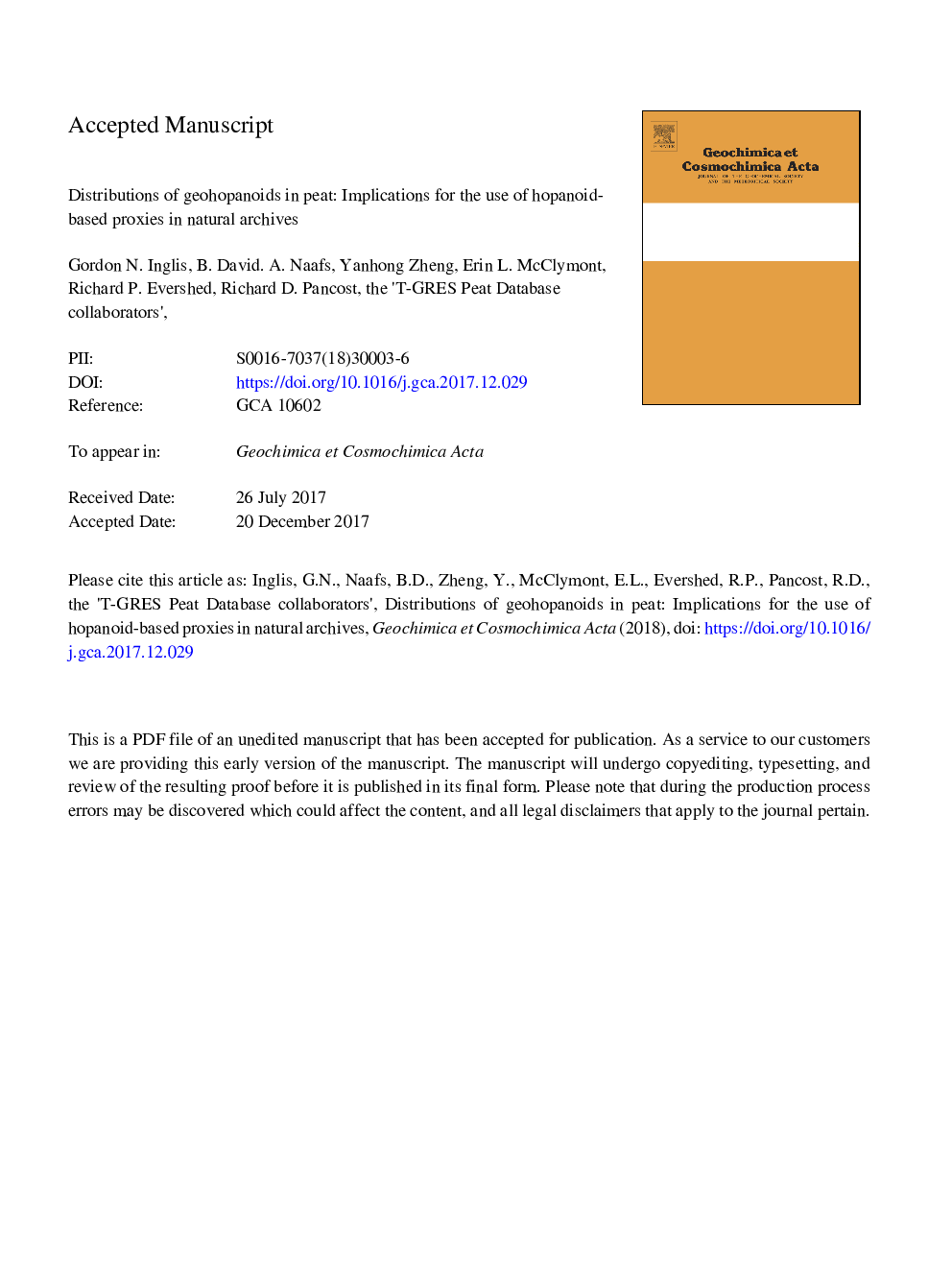| کد مقاله | کد نشریه | سال انتشار | مقاله انگلیسی | نسخه تمام متن |
|---|---|---|---|---|
| 8910877 | 1637933 | 2018 | 34 صفحه PDF | دانلود رایگان |
عنوان انگلیسی مقاله ISI
Distributions of geohopanoids in peat: Implications for the use of hopanoid-based proxies in natural archives
ترجمه فارسی عنوان
توزیع جیوهوپانوئیدی در ذغال سنگ ذغال سنگ: پیامدهای استفاده از پروکسی های مبتنی بر هپانویو در آرشیوهای طبیعی
دانلود مقاله + سفارش ترجمه
دانلود مقاله ISI انگلیسی
رایگان برای ایرانیان
کلمات کلیدی
باکتری، هاپانوئیدها، ذغال سنگ نارس، سنگ قیمتی، تشخیص، ایزومریزی،
موضوعات مرتبط
مهندسی و علوم پایه
علوم زمین و سیارات
ژئوشیمی و پترولوژی
چکیده انگلیسی
Hopanoids are pentacyclic triterpenoids produced by a wide range of bacteria. Within modern settings, hopanoids mostly occur in the biological 17β,21β(H) configuration. However, in some modern peatlands, the C31 hopane is present as the 'thermally-mature' 17α,21β(H) stereoisomer. This has traditionally been ascribed to isomerisation at the C-17 position catalysed by the acidic environment. However, recent work has argued that temperature and/or hydrology also exert a control upon hopane isomerisation. Such findings complicate the application of geohopanoids as palaeoenvironmental proxies. However, due to the small number of peats that have been studied, as well as the lack of peatland diversity sampled, the environmental controls regulating geohopanoid isomerisation remain poorly constrained. Here, we undertake a global approach to investigate the occurrence, distribution and diagenesis of geohopanoids within peat, combining previously published and newly generated data (nâ¯=â¯395) from peatlands with a wide temperature (â1 to 27â¯Â°C) and pH (3-8) range. Our results indicate that peats are characterised by a wide range of geohopanoids. However, the C31 hopane and C32 hopanoic acid (and occasionally the C32 hopanol) typically dominate. C32 hopanoic acids occur as αβ- and ββ-stereoisomers, with the ββ-isomer typically dominating. In contrast, C31 hopanes occur predominantly as the αβ-stereoisomer. These two observations collectively suggest that isomerisation is not inherited from an original biological precursor (i.e. biohopanoids). Using geohopanoid ββ/(αβâ¯+â¯Î²Î²) indices, we demonstrate that the abundance of αβ-hopanoids is strongly influenced by the acidic environment, and we observe a significant positive correlation between C31 hopane isomerisation and pH (nâ¯=â¯94, r2â¯=â¯0.64, pâ¯<â¯0.001). Crucially, there is no correlation between C31 hopane isomerisation and temperature. We therefore conclude that within peats, αβ-hopanoids are acid-catalysed diagenetic products and their occurrence at shallow depths indicates that this isomerisation is rapid. This shows that geohopanoid ββ/(αβâ¯+â¯Î²Î²) indices can be used to reconstruct pH within modern and ancient peat-forming environments. However, we only recommend using ββ/(αβâ¯+â¯Î²Î²) indices to interrogate large amplitude (>1 pH unit) and longer-term (>1â¯kyr) variation. Overall, our findings demonstrate the potential of geohopanoids to provide unique new insights into understanding depositional environments and interpreting terrestrial organic matter sources in the geological record.
ناشر
Database: Elsevier - ScienceDirect (ساینس دایرکت)
Journal: Geochimica et Cosmochimica Acta - Volume 224, 1 March 2018, Pages 249-261
Journal: Geochimica et Cosmochimica Acta - Volume 224, 1 March 2018, Pages 249-261
نویسندگان
Gordon N. Inglis, B. David A. Naafs, Yanhong Zheng, Erin L. McClymont, Richard P. Evershed, Richard D. Pancost, the 'T-GRES Peat Database collaborators' the 'T-GRES Peat Database collaborators',
